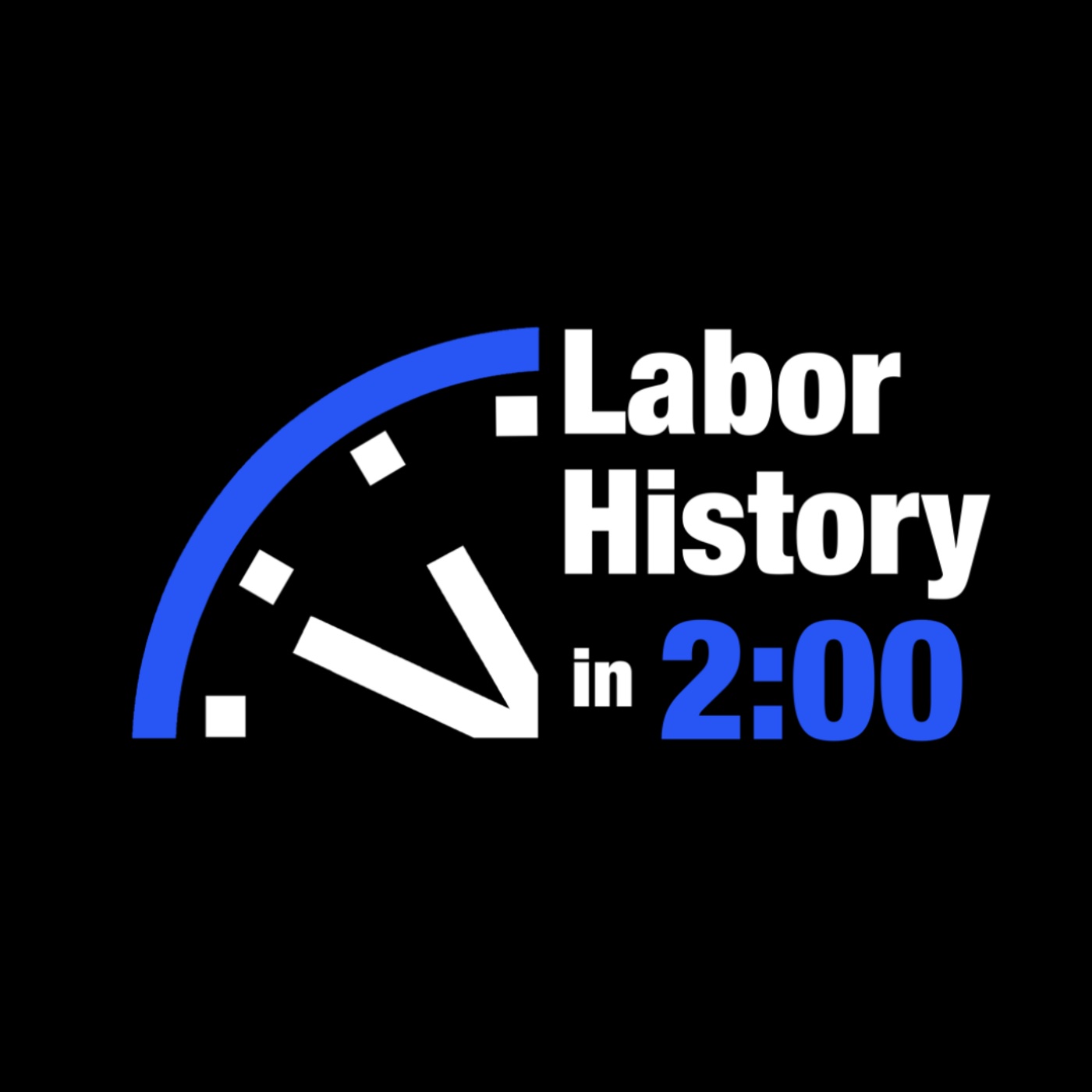Episodes
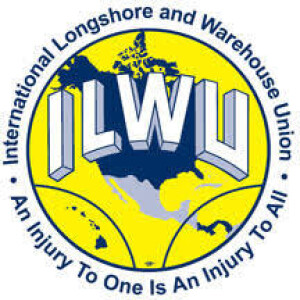
Friday Jul 19, 2024
July 19 - The ‘34 General Strike in San Francisco Winds Down
Friday Jul 19, 2024
Friday Jul 19, 2024
On this day in labor history, the year was 1934.
That was the day San Francisco’s Central Labor Council voted narrowly to end the general strike, then in its fourth day.
It had been one of three historic strikes that turned the tide towards industrial organizing in the 1930s.
It emerged as part of the ongoing longshoreman’s strike, which started in May.
The decision was controversial.
Longshoremen and seamen raged that leadership of the strike had been torn from them by more conservative elements.
As author of Workers on the Waterfront, Bruce Nelson puts it, “after two and a half months on strike, literally thousands of arrests, at least six deaths and hundreds of serious injuries, the men and their families were holding the line.
But their allies were gradually cutting the ties of solidarity that had been the strike’s lifeblood.”
The shipping bosses forced a vote for arbitration from the longshoremen, and withoutthe seamen.
As Nelson notes, this served to drive a wedge between the two unions, creating a rift that would only deepen.
The two would continue to strike until the end of July.
But the strike left longshoremen emboldened.
They pushed back on the job, driving off scabs and establishing work rules and conditions ahead of the arbitrator’s ruling, which came in October.
The hiring hall was finally established.
While it was decided that the union and the shipping bosses would rule the hall jointly, the union controlled the position of dispatcher.
This meant the union determined hiring, which put an end to the despised ‘shape-up.’
The award also mandated wage raises and a coast-wide contract.
It would serve as a catalyst for the founding of the ILWU three years later.
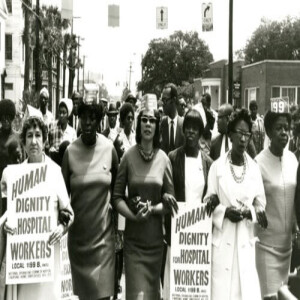
Thursday Jul 18, 2024
July 18 - Striking for Dignity
Thursday Jul 18, 2024
Thursday Jul 18, 2024
On this day in labor history, the year was 1969.
That was the day hospital workers in Charleston, South Carolina won union recognition.
The 113-day strike reflected all the broader social issues of the day.
Led primarily by black women, the strike at the Medical College, Charleston County and several other hospitals intersected civil rights and racial and gender discrimination on the job.
Jewel Charmaine Debnam notes that women like Local 1199B president Mary Moultrie, Naomi White and others were “essential to the strike not only as daily participants on the picket line but also as leaders of the local movement establishment.”
For months, strikers marched, walked picket lines, clashed with police and held vigils demanding their right to organize.
They defied injunctions and endured hundreds of arrests, nightly curfews and confrontation with the State National Guard.
Governor McNair and the hospital boards had initially refused to concede to the workers’ demands for union recognition.
They claimed workers paid with public funds could not engage in collective bargaining. But the women were steadfast.
They pointed to the wage disparities between black and white workers and between male and female workers.
They also protested the blatant disrespect and discrimination meted out daily by management.
Local longshoremen solidarized with the strikers and threatened a walkout in support if their demands were not met.
Coretta Scott King and many other Civil Rights leaders also played a supportive role.
Finally, the new union won reinstatement of fired workers, which had touched off the strike, a solid grievance procedure, a minimum wage raise and access to the credit union.
Victory would be short lived however when the State almost immediately refused to hold up its end of the agreement.

Wednesday Jul 17, 2024
July 17 - Lumber Workers Put Down Their Axes
Wednesday Jul 17, 2024
Wednesday Jul 17, 2024
On this day in labor history, the year was 1917.
That was the day 50,000 lumber workers across the Pacific Northwest participated in an industry-wide strike, called by the Industrial Workers of the World.
The IWW had been organizing loggers for years around wages, hours, working conditions and camp sanitation.
The IWW began building for the strike in the aftermath of the Everett Massacre the previous fall.
Elizabeth Gurley Flynn started touring camps in Idaho.
By March, the Wobblies established Local 500 of the Lumber Workers Industrial Union in Spokane to organize actions across the region.
In his book, Empire of Timber, historian Erik Loomis details the chronology of events that led to the momentous walkout.
In Idaho, loggers began walking off the job in April, when demands for improved bunkhouses and food, higher wages and the eight-hour day were refused.
The strike spread to Washington State, the rest of Idaho and into Montana and Oregon.
Loomis notes that by August, “they made employers feel their wrath.” The strike cut production by over 80% and threatened war materiel.
Infuriated timber bosses demanded federal troops be sent in to crush the strike and IWW leaders be prosecuted for treason and sabotage.
Raids and arrests were orchestrated throughout the Pacific Northwest and the strike began to stall.
After 10 weeks, the IWW called off the strike but instructed workers to quit work after eight hours.
They continued to lead sanitation-related job actions that would substantially change conditions for the better.

Tuesday Jul 16, 2024
July 16 - Bloody Thursday
Tuesday Jul 16, 2024
Tuesday Jul 16, 2024
On this day in labor history, the year was 1934. That was the day fatalities on Bloody Thursday touched off a four-day general strike in San Francisco.
It was the first time a general strike had shut down a major U.S. port city. The strike had been raging since May. Workers battled with police days earlier as the shipping bosses tried to force open the docks. Two workers were killed. More than 40,000 poured into Market Street to march silently in their funeral procession.
Outrage fueled plans for a general strike. Twenty-one unions across the city voted to walk. In his book Strike!, Jeremy Brecher notes the momentum for a general strike was unstoppable, despite attempts by AFL leaders to prevent it.
By 8 a.m. on this day, the San Francisco General Strike began. Over 150,000 workers including teamsters and butchers, restaurant and transit workers joined longshoremen and seafarers in shutting down the ports, the city and the highways.
But as Brecher points out, the strike was met with a powerful counter-attack. Hundreds of special deputies were sworn in. The National Guard was called out, “complete with infantry, machine guns, tank and artillery units; state officials were poised on the edge of declaring martial law.”
Vigilante raids began on the 17th, with assaults on the Marine Workers Industrial Union and the offices of the Western Worker newspaper and strike bulletin. Many other gathering places and homes where strikers regularly met were also busted up. Hundreds were rounded up, beaten and arrested.
The city’s Central Labor Committee authorized exceptions that eroded the strike’s power. In the face of violent raids and opposition from AFL leaders, the General Strike Committee voted to end the strike.

Monday Jul 15, 2024
July 15 - The 1959 Steel Strike
Monday Jul 15, 2024
Monday Jul 15, 2024
On this day in labor history, the year was 1959.
That was the day half a million steel workers walked off the job in a historic, 116-day strike to defend work rules.
It was the largest industry-wide strike and also the last.
The strike affected 12 steel companies and shut down more than 85% of steel production. Mill owners refused to grant wage increases unless the union agreed to changes in the contract.
Specifically, they were looking to eliminate Section 2 (b), titled “Local Working Conditions.”
The bosses wanted the ability to change the number of workers assigned to any given task.
They also wanted to introduce machinery and rules that would reduce labor hours and cut the work force.
USWA members understood this as an assault on workplace safety and a move to break the union.
Mill bosses hoped that a long strike would provoke the membership to abandon their union.
But, according to Jack Metzgar, author of Striking Steel, members had grown used to walkouts every 3 years and planned accordingly.
As well, the USW had a “well-oiled machinery including an internal welfare system for hardship cases and also reached out to merchants, banks, charitable agencies, and local and state governments” to organize relief.
By the end of August, the Defense Department stoked anxieties that national security was at risk.
Three months into the strike, union funds dwindled. Strikers felt the pinch.
President Eisenhower invoked a Taft-Hartley injunction, hoping to force strikers back to work.
As the union rose to challenge Taft-Hartley’s constitutionality, solidarity among the mill owners crumbled.
Kaiser Steel broke ranks and settled separately.
Their contract granted wage increases and preserved section 2(b).
It set the precedent for the contract that was eventually signed industry-wide.
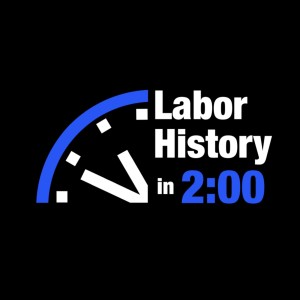
Sunday Jul 14, 2024
July 14 - A Summer of Public Sector Strikes
Sunday Jul 14, 2024
Sunday Jul 14, 2024
On this day in labor history, the year was 1978.
That was the day municipal workers in Cleveland, Louisville and Philadelphia walked off the job.
That summer was rocked with public sector strikes, starting with a firefighters strike in Memphis.
In Cleveland, municipal services came to a virtual halt as city workers honored a police work stoppage.
In Louisville, firefighters walked off the job, after the Kentucky Labor Relations Board found the city guilty of unfair labor practices.
And in Philadelphia, 20,000 AFSCME members, including sanitation, highway and health department workers rejected a last minute contract offer.
They demanded wage increases.
But they were also furious when the city announced it would have to lay off city workers to pay an arbitration award to the police.
Sanitation strikes soon followed in New Orleans, San Antonio, Detroit and Tuscaloosa.
By the third week of July, transit workers in Washington DC staged a wildcat strike, as did postal workers in California and New Jersey.
Labor historian Joseph McCartin notes that public sector strikes peaked in 1975 and again in 1978.
By the late 70s, “the volatile recipe of rising public sector union militancy, inflation and anti-tax reform made public sector unions more vulnerable than at any other time.
Suddenly the union became a convenient scapegoat for public officials dealing with declining relative tax revenues, demands for improved public services and taxpayer unrest.”
McCartin adds that by 1978 public employers came out swinging in labor disputes.
Public sector unions would struggle to “hold their own in an increasingly hostile environment…as their ability
to strike was being severely eroded.”
The backlash against public sector militancy set the stage for President Reagan’s smashing of PATCO just 3 years later.

Saturday Jul 13, 2024
July 13 - Striking News in Detroit
Saturday Jul 13, 2024
Saturday Jul 13, 2024
On this day in labor history, the year was 1995.
That was the day 2500 pressmen, reporters, drivers and clerks went on strike against the Detroit Newsand the Free Press.
Both newspapers had created a virtual monopoly in 1988 by merging their advertising and circulation departments into the Detroit Newspaper Association.
Even as the DNA raked in record profits, they forced years of concessions, including wage freezes and lay offs.
When the Association implemented a merit raise system, the Newspaper Guild voted to strike.
Five other unions, including CWA and Teamsters soon followed.
The newspapers were ready. Just before the strike, they cut off the dues check-off.
They also contracted with the company, Alternative Work Force, to provide scabs.
And they hired private security guards from Huffmaster and Vance International to enforce the scab herding.
A solid union boycott cut revenues for both newspapers.
On August 19, hundreds of strikers stopped scabbing until police attacked the picket lines, breaking arms and arresting at least four.
Then, on Labor Day weekend, thousands of strikers and supporters successfully repulsed police forces amassed from across the state to break up picket lines.
By mid-September, both newspapers were forced to airlift the Sunday edition until strikebreaking injunctions limited pickets.
Over a hundred had been arrested over the course of several weeks.
Unable to stop production, strikers gradually returned to work until the strike was finally called off in February 1997.
In his two volume set, Workers in America, Robert Weir notes that many labor activists criticized strike tactics.
They argued direct action to stop production should have been the priority rather than boycotts and political pressure.
Once the strike ended, the DNA claimed all but a few had forfeited their jobs.
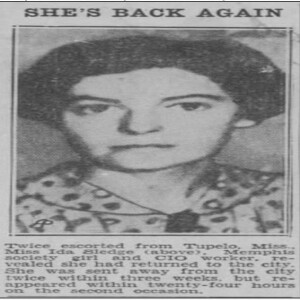
Friday Jul 12, 2024
July 12 - The ILGWU Comes to Tupelo
Friday Jul 12, 2024
Friday Jul 12, 2024
On this day in labor history, the year was 1937. That was the day newspapers throughout the South announced the return of Ida Sledge to Tupelo, Mississippi.
The ILGWU organizer had been leading unionization efforts at three area mills. Twice she was driven out. Prominent businessmen “invited” her to leave town just days earlier, warning her not to return under threat of violence.
Earlier that spring, workers held a sit-down strike at the Tupelo Cotton Mill. They demanded higher wages and shorter hours in the town’s first labor action ever. The mill’s stockholders responded by voting to liquidate. Sledge immediately filed charges with the NLRB against the mills for violating the Wagner Act.
Now, newspapers reported a tense atmosphere in Tupelo with Sledge’s return. She stated, “I don’t mean to cause any trouble. I intend to organize the garment workers and don’t propose to be scared away.”
The citizens committee soon declared victory, claiming they had organized 1000 workers at five plants into ‘independent,’ ‘home’ unions. Sledge condemned these as company unions.
By the end of the month, Democratic Representative of Mississippi, John Rankin thundered, “these representatives of the so-called Labor Relations Board boasted they were going to close every factory in the city before they quit and that when they got through with it, there would be no Tupelo left.”
The following spring, local organizer Jimmy Cox was taken outside of town and flogged by 15 men. Sledge was again threatened and driven away permanently. The mill owners finally relented in August as the NLRB trial loomed. They disbanded their company unions, reinstated fired workers with back pay and posted notices they would not interfere with organizing efforts. But the ILGWU never gained much from their organizing efforts
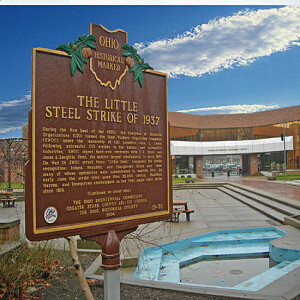
Thursday Jul 11, 2024
July 11 - The Little Steel Strike Begins to Collapse
Thursday Jul 11, 2024
Thursday Jul 11, 2024
On this day in labor history, the year was 1937.
The Little Steel Strike was beginning to collapse.
Strikers in Massillon, Ohio had gathered that Sunday night at union headquarters across from Republic Steel’s Massillon Works.
As Ahmed White describes in his book, The Last Great Strike, the union had organized weekly festivities on Sunday nights, including food, live music and dancing.
For weeks, the Law and Order League had repeatedly demanded special police be deputized and armed to crush the strike.
By early July, Ohio National Guardsmen ensured the forcible reopening of the mill.
One self-appointed special deputy leader, Major Curley decided tonight would be the night he was going to “clean out that God Damned hall.”
He provocatively positioned his deputies in front of union headquarters.
First he ordered his deputies to fire on picketers attempting to block the gate at shift change.
When strikers hurled bottles and rocks in response, the deputies unleashed massive rounds of gunfire and tear gas for more than half an hour.
Guardsmen, railroad and company police joined in the anti-SWOC siege.
Two strikers were dead.
Nick Valdos was shot in the hip as he attempted to aid wounded strikers.
Fulgencio Calzara was shot in the back of the head in front of union headquarters.
Another seven strikers were shot and seriously wounded.
At least four more were hospitalized with injuries.
Police forces ransacked the hall, seizing union records and membership lists.
They continued their rampage through the neighborhood, ransacking homes and arresting anyone suspected of ties to the union.
As many as 165 were arrested and held for several days.
As White notes, the NLRB and the LaFollette Commission both concluded that blame for the evening’s violence lay with Republic.
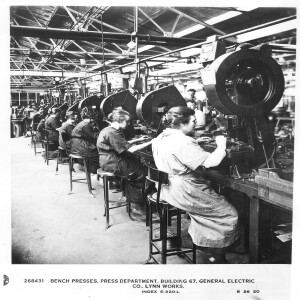
Wednesday Jul 10, 2024
July 10 - Organizing During Wartime
Wednesday Jul 10, 2024
Wednesday Jul 10, 2024
On this day in labor history, the year was 1918.
That was the day machinist John Connolly was fired from General Electric’s sprawling River Works in West Lynn, Massachusetts.
Firings of several more labor activists prompted 14,000 workers, 40% of them women, to walk off the job and flood the ranks of the IAM and the IBEW.
The newly established War Labor Board emboldened GE workers.
They looked to the board for help in beating back yellow dog contracts and to organize bonafide unions.
A Metal Trades Council had finally been established at the GE plant in Schenectady, NY.
Workers hoped to do the same at Lynn.
After Connolly’s discharge, GE managers fired another fourteen activists three days later.
As Joseph McCartin describes in his book, Labor’s Great War, thousands of outraged workers met the evening of the firings and determined there was nothing left to do but strike.
The walkout began the following Monday.
David Montgomery describes the scene in The Fall of the House of Labor: “Early in the afternoon, union sound trucks outside the building blared fighting songs and calls to down tools. Within an hour, the GE river works were empty.”
The strike lasted three weeks.
In that time, strikers defeated attempts at arbitration, demanding the Board rule on their behalf as it had done for GE workers in Schenectady.
In October, the board adjusted wages, ordered reinstatement of all but two of the fired workers and established minimum pay for women.
It also ordered the election of shop committees.
Lynn River Works was now 95% organized.
Victory was short-lived however.
In the post-war period, unions at GE and elsewhere were summarily defeated by vigorous open shop drives across the country.

